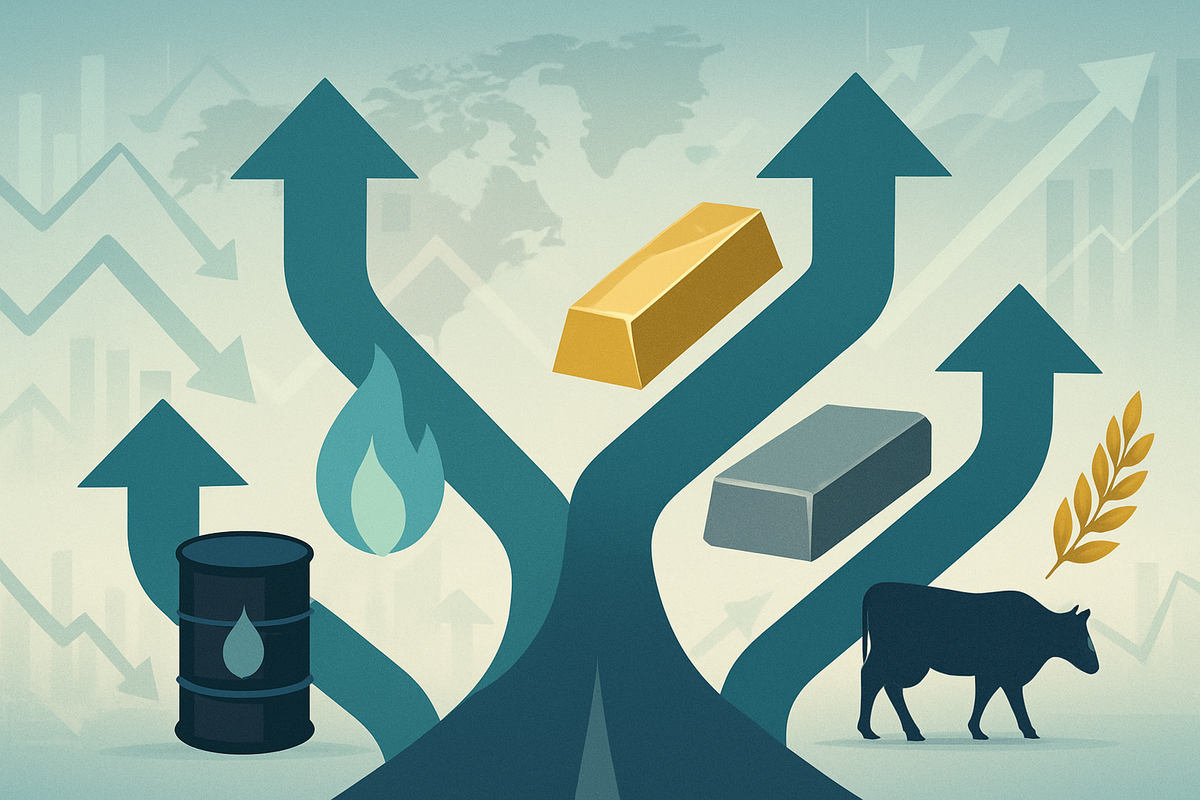
As the global economy inches towards Q4 2025, the commodity market stands at a critical juncture, poised for a period of heightened volatility and diverging trends. While a broad softening of prices is anticipated across the board due to a projected global economic slowdown, specific commodity classes are charting markedly different courses. Investors and market participants are bracing for a complex landscape where geopolitical tensions, evolving energy transition dynamics, and unique supply-demand fundamentals will dictate fortunes. The overall sentiment leans towards caution, but with clear opportunities emerging in select sectors, particularly within precious metals and natural gas.
The immediate implications for the market are significant. Persistent inflation in key economies, coupled with anticipated interest rate cuts by central banks like the Federal Reserve, is creating a nuanced environment. A potentially sideways or declining U.S. dollar could remove a traditional headwind for commodity prices, while ongoing geopolitical conflicts continue to fuel uncertainty and safe-haven demand. This intricate web of factors necessitates a granular approach to understanding the commodity market's trajectory, moving beyond aggregate trends to pinpoint the specific dynamics at play within energy, metals, and agriculture.
Detailed Market Dynamics: A Sector-by-Sector Breakdown
The Q4 2025 commodity market is far from monolithic, with each sector responding to a distinct set of drivers. Global economic growth, geopolitical events, and central bank monetary policies remain the overarching influences, but their impact is filtered through specific supply-demand dynamics.
Energy Commodities: A Tale of Two Fuels
The energy sector presents a stark contrast. Crude oil is expected to face significant downward pressure, with Brent crude prices projected to average around $58-$59 per barrel (b) in Q4 2025 and potentially dipping to $50/b in early 2026. This bearish outlook is primarily driven by large global oil inventory builds as OPEC+ members increase production and robust non-OPEC supply growth, notably from the U.S., Brazil, Canada, Norway, and Guyana. Moderating global demand growth, particularly from China, further contributes to this trend. Despite current short-term spikes due to Russian supply disruptions, analysts largely maintain a bearish medium-term outlook, anticipating that geopolitical risks, while elevated, will not sustain a prolonged price rally.
Conversely, natural gas (Henry Hub) is poised for a bullish run, with spot prices expected to rise to an average of $3.70-$4.11 per million British thermal units (MMBtu) in Q4 2025. This surge is attributed to relatively flat U.S. natural gas production coinciding with a significant increase in U.S. liquefied natural gas (LNG) exports, driven by strong global demand, especially from Europe. U.S. natural gas storage inventories are projected to remain below the five-year average, exacerbating upward price pressure. Europe's accelerated efforts to phase out Russian LNG imports and pledges to secure U.S. LNG create a robust demand floor, despite some concerns about short-term global oversupply from new liquefaction capacity.
Metals: Precious Shine, Industrial Moderation
The metals sector also shows divergence. Precious metals, particularly gold and silver, are experiencing extraordinary highs and are expected to maintain their bullish momentum. Gold prices have breached $3,700 per ounce in 2025, with forecasts suggesting an average of $3,675/oz in Q4 2025 and potentially reaching $4,000/oz by mid-2026. This rally is fueled by persistent safe-haven demand amid geopolitical risks, recession probabilities, strong central bank diversification, and anticipated U.S. interest rate cuts. Silver has similarly surged, hitting 14-year highs above $44 per ounce, driven by its safe-haven appeal and robust industrial demand from green energy investments (e.g., solar panels) and electronics. While short-term corrections are anticipated, the overall sentiment for precious metals remains firmly bullish.
Industrial metals, however, face a more mixed outlook. Prices for most industrial metals are generally forecast to decline by around 10% in 2025 due to slowing global growth and trade tensions. Copper, an exception, is expected to see upward movement in early Q4 2025 due to macro recovery expectations and ore supply tightness, with Goldman Sachs (NYSE: GS) forecasting prices to rise to $10,200 per metric ton (mt) in Q4 2025. Aluminum prices are also supported by low visible inventory coverage, creating a stable price floor, and are expected to fluctuate upward. However, the overall trend for industrial metals will be heavily influenced by China's economic performance and global manufacturing activity.
Agricultural Commodities: Oversupply vs. Scarcity
The agricultural sector presents a bifurcated landscape. Grains like corn, wheat, and soybeans are largely expected to face downward pressure in Q4 2025 due to comfortable supplies and robust harvests. The U.S. saw a historic surge in corn production, leading to oversupply risks. China's reduced import demand for these staples is a crucial bearish factor. Crop farmers may face compressed margins, despite safety net programs from the 2025 Farm Bill.
In stark contrast, the livestock sector, particularly cattle, is experiencing multi-year highs. The U.S. cattle inventory has contracted sharply to its lowest since 1973, leading to tight supplies and strong prices. This trend is expected to continue into 2025 due to persistent demand for beef and challenges in rebuilding herds. Pork production is projected to grow steadily through 2034, though some forecasts suggest lower hog prices due to production reductions and weaker demand. Soft commodities like cocoa and coffee, after earlier surges due to weather disruptions, are likely to see price declines as production recovers.
Corporate Fortunes: Winners and Losers in a Volatile Market
The divergent commodity trends of Q4 2025 will create clear winners and losers among public companies, significantly impacting their operations, revenue, and stock performance.
Oil & Gas Sector: Losers: Oil Exploration & Production (E&P) companies such as ExxonMobil (NYSE: XOM), Chevron (NYSE: CVX), and Occidental Petroleum (NYSE: OXY) will likely see reduced revenues and squeezed profit margins due to lower crude oil prices. Oilfield Services (OFS) providers like SLB (NYSE: SLB), Halliburton (NYSE: HAL), and Baker Hughes (NASDAQ: BKR) will also face reduced demand for their services as E&P firms cut capital expenditure. Winners: Conversely, lower crude oil prices translate directly to reduced jet fuel costs for airlines like Delta Air Lines (NYSE: DAL), Southwest Airlines (NYSE: LUV), and United Airlines (NASDAQ: UAL), boosting their profit margins. Transportation and logistics giants such as FedEx (NYSE: FDX) and UPS (NYSE: UPS) will also benefit from lower fuel expenses. Natural Gas Winners: Natural gas producers like EQT Corporation (NYSE: EQT), Chesapeake Energy (NASDAQ: CHK), and Antero Resources (NYSE: AR) are poised for increased revenues and improved profitability from rising natural gas prices. LNG export companies, including Cheniere Energy (NYSE: LNG) and Tellurian Inc. (NASDAQ: TELL), will capitalize on increased export volumes and strong global demand. Midstream companies such as Kinder Morgan (NYSE: KMI) and Energy Transfer (NYSE: ET) will benefit from increased natural gas transportation and storage demand.
Metals Sector: Precious Metals Winners: Gold mining companies like Barrick Gold (NYSE: GOLD), Newmont (NYSE: NEM), and Agnico Eagle Mines (NYSE: AEM) will see direct revenue increases and improved profit margins from elevated gold prices. Silver mining companies such as Pan American Silver (NASDAQ: PAAS) and First Majestic Silver (NYSE: AG) will similarly benefit from surging silver prices. Precious metals royalty and streaming companies like Franco-Nevada (NYSE: FNV) and Wheaton Precious Metals (NYSE: WPM) will see the value of their agreements rise without direct operational mining risks. Industrial Metals Winners: Copper mining companies like Freeport-McMoRan (NYSE: FCX) and Southern Copper (NYSE: SCCO) are expected to benefit from strong copper demand driven by the energy transition, leading to higher revenues. Aluminum producers such as Alcoa (NYSE: AA) and Century Aluminum (NASDAQ: CENX) could see improved margins from upward-fluctuating prices and tight supply.
Agricultural Sector: Grain Losers: Agricultural equipment manufacturers like Deere & Company (NYSE: DE), CNH Industrial (NYSE: CNHI), and AGCO Corporation (NYSE: AGCO) may experience reduced sales as farmers facing lower crop prices cut capital expenditures. Agricultural commodity trading and processing companies, especially those with undiversified portfolios, like Archer Daniels Midland (NYSE: ADM) and Bunge Global SA (NYSE: BG), could face squeezed margins and inventory write-downs from declining grain prices. Livestock Winners: Cattle ranchers and beef processors, including companies with significant beef operations like Tyson Foods (NYSE: TSN) and JBS S.A. (OTC: JBSAY), are expected to benefit from high cattle prices and robust consumer demand for beef, translating to increased revenue and profitability.
Broader Implications: Reshaping Global Commerce
The Q4 2025 commodity outlook extends beyond immediate price movements, intertwining with profound shifts in global industry, trade, and policy.
The Energy Transition and Critical Minerals: The accelerating global energy transition is a dominant force, shifting the world from a fuel-intensive to a material-intensive energy system. This is fueling unprecedented demand for critical minerals like copper, nickel, lithium, and rare earth elements, essential for electric vehicles and renewable energy infrastructure. This surge could ignite a new supercycle in critical commodities, positioning mining companies focused on these materials as long-term beneficiaries. While coal plant retirements accelerate in regions like the EU, the landscape for fossil fuels remains complex, with potential policy shifts in some nations prioritizing domestic production.
Deglobalization and Supply Chain Resilience: A discernible trend towards deglobalization, driven by geopolitical tensions, national security concerns, and a desire for self-sufficiency, is fundamentally reshaping commodity supply chains. Companies are increasingly diversifying and regionalizing their supply networks through reshoring, nearshoring, and "friendshoring" to mitigate risks exposed during recent global disruptions. This re-architecting may increase production costs but enhances resilience against future shocks, contributing to a more fragmented global trade environment and declining overall trade volume across commodities.
Regulatory and Policy Headwinds: Trade policies and tariffs continue to play a significant role. The U.S. is implementing tariffs on various goods, while the EU is reducing steel import quotas and increasing tariffs, aligning with North American measures. These protectionist policies can dampen global industrial activity and impact demand for industrial metals and agricultural products, creating ripple effects across markets. Environmental regulations, such as accelerated coal plant retirements, are also shaping energy commodity demand. Furthermore, central bank monetary policies, including anticipated interest rate cuts, will influence the U.S. dollar's strength, which in turn impacts dollar-denominated commodity prices.
Historical Context: Commodity markets are inherently cyclical, prone to boom-bust patterns that have historically lasted almost six years. The period since 2020 has seen exceptionally large price swings, with volatility surpassing any decade since the 1970s. While some observers anticipate a new commodity supercycle driven by the clean technology transition, historical supercycles ultimately ended with significant price corrections, underscoring the need for caution. Geopolitical events, much like the Russia-Ukraine conflict's impact on oil prices, have consistently demonstrated their capacity to disrupt commodity markets.
The Road Ahead: Navigating Future Challenges and Opportunities
As Q4 2025 unfolds and the market looks beyond, several short-term and long-term possibilities, strategic adaptations, and emerging opportunities will define the commodity landscape.
Short-Term Outlook (Q4 2025 - 2026): Overall commodity prices are projected to decline through 2026, reaching a six-year low, primarily due to slowing global economic growth. Oil prices are expected to continue their descent, while natural gas prices show more stability or even increases. Industrial metals generally face declines, though copper remains an exception due to energy transition demand. Precious metals are expected to continue their bullish run. Agricultural commodity prices are projected to decline gradually, although localized climate events will drive volatility.
Long-Term Outlook (Beyond 2026): The long-term narrative is heavily influenced by the green transition. A potential "Commodity Supercycle" driven by demand for critical minerals (lithium, copper, nickel, rare earths) for EVs and renewable energy infrastructure is a significant possibility. Demand for copper alone is projected to grow by 30% by 2040. Gold's long-term outlook remains bullish, with projections of $4,200-$4,800 per ounce by 2027-2028 and potentially higher by 2030, driven by its safe-haven appeal and central bank buying. Global oil demand is likely to plateau between 2025 and 2035, with non-OECD economies becoming primary drivers.
Strategic Pivots and Adaptations: Market participants must prioritize robust risk management and diversification across commodity classes and geographies to navigate persistent volatility. Enhancing supply chain resilience through regionalization and de-risking strategies will be crucial. Adapting to shifting trade flows, potentially seeking new trade partners and routes amidst rising protectionism, is also vital. Companies will increasingly focus on working capital solutions to manage heightened risk and liquidity needs. Technological adoption, including digital and AI advancements, will drive innovation in trade finance and operational efficiency. Mergers and acquisitions in the battery industry are anticipated as Chinese players potentially acquire distressed Western companies to diversify supply chains.
Emerging Opportunities and Challenges: India is poised for significant growth, with its middle class driving substantial consumption across energy, metals, and agricultural products, making it a key demand center. Southeast Asia and Africa will play larger roles in sustaining global oil consumption. China's evolving economy, shifting from infrastructure to consumption, creates divergent impacts: traditional metals face moderating demand, while those critical to electronics and green technology continue robust growth. The growth of data centers, fueled by AI and cloud applications, is driving demand for natural gas and metallic cables. Challenges include trade restrictions fragmenting global trade, potentially affecting dollar availability in developing nations, and securing critical mineral supplies amidst potential deficits and geopolitical competition.
Wrap-Up: A Market in Motion
The Q4 2025 commodity market is a landscape of stark contrasts and dynamic shifts. While a general softening of prices is anticipated due to weakening global economic growth, this aggregate view masks significant divergence. Energy transition minerals and precious metals are poised for potential long-term strength, buoyed by structural demand and safe-haven appeal. In contrast, traditional industrial metals and many agricultural commodities may face more substantial headwinds from oversupply and slowing demand.
Moving forward, investors should watch for continued geopolitical developments, central bank monetary policy decisions, and the pace of global economic recovery, particularly in China. The ongoing re-architecting of global supply chains and the accelerating energy transition will be fundamental drivers of long-term value creation and destruction. Agility, robust risk management, and a deep understanding of sector-specific fundamentals will be paramount for successfully navigating this complex and evolving commodity market.
This content is intended for informational purposes only and is not financial advice






